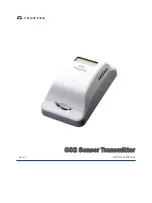
05-362
11
EN
C. Push button function for roll-down shutters
The jumper (J) is not installed. The three-channel transmitter transmits a switching command as long
as the push button remains depressed, up to a maximum of 10 seconds. The inputs cannot be switched
simultaneously.
Push button 1: input T1 – code A
Push button 2: input T2 – code B
5. Complete installation with a blank plate or a finishing set.
6. Switch on the power.
7. Program the three-channel transmitter to the selected wireless Easywave receiver (see receiver manual).
If you now operate the switch or push button, the three-channel transmitter transmits the corresponding switching command to the receiver.
3. OPERATION AND USE
3.1. General operation
By using this wireless Easywave three-channel transmitter, you can expand the switching functions of existing switches or push buttons via a receiver.
The three-channel transmitter checks whether a switch/push button is live and transmits the corresponding Easywave code (A, B, C or D) to the wireless Easywave
receiver, which in turn switches the consumer.
3.2. Detection range between Easywave hand-held transmitters and wireless Easywave receivers
The operation of devices that are controlled via a remote control unit, such as TVs or video and audio devices, is not disrupted by an Easywave hand-held
transmitter. You are not required to optically aim the hand-held transmitter at the wireless Easywave receiver. The indoor detection range is approximately 30 m.
In open spaces, a detection range of 100 m is attained. The range of the hand-held transmitter depends on the materials used in the residence. You can use a
diagnostic device (05-370) to determine the wireless signal strength in a given area. The device recognizes all 868.3 MHz signals. Based on nine status LEDs,
the reception quality of the transmission signal or the strength of the interference signals present is displayed. This way you can determine whether the range
of the hand-held transmitter is sufficient. Figure 1 shows the loss of quality of the transmission range depending on the materials used. You can use a wireless
Easywave repeater (05-535) in installations with insufficient range.
4. TROUBLESHOOTING
If the Easywave system does not work after being programmed, you can always
first
perform a number of
extra checks
:
• Check whether the
shield between the battery and the contacts in the three-channel transmitter
has been removed.
• Check the
operation of the connected receiver
. Press the programming button (P) on the front of the receiver. If the status LED does not flash, the
receiver is defective.
• Check the wireless signal strength in the vicinity with a diagnostic device (05-370). If the range is insufficient, move the push button or use a wireless
Easywave repeater (05-535) to increase the range.
• In the case of an existing installation, check whether the
surroundings of the Easywave system
have changed, possibly causing interference (metal
electricity cabinet, walls, moved furniture ...). Restore the original arrangement, if possible.
5. TECHNICAL DATA
dimensions
25 x 48 x 48 mm (HxWXD)
weight
32 g
frequency
868.3 MHz
modulation
FSK
power supply voltage
230 Vac, 50 Hz
maximum power consumption
0.7 W
range
approximately 150 m in open spaces
protection degree
IP20
operating temperature
-20 – +60°C
quality mark
CE marking in accordance with EN 60669-2-1
T2
T1
J
N L
T2 T3
T1
N
230 V
L
ZU
AUF
L


































